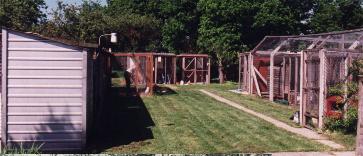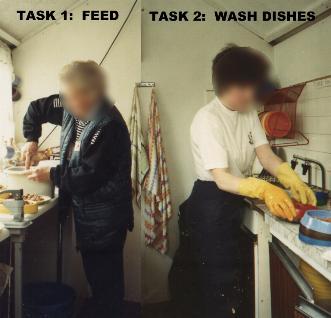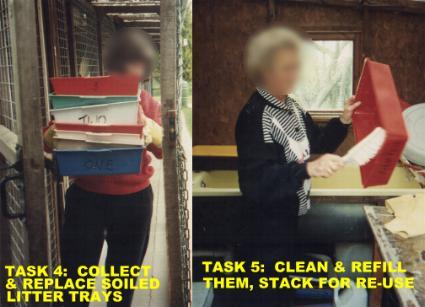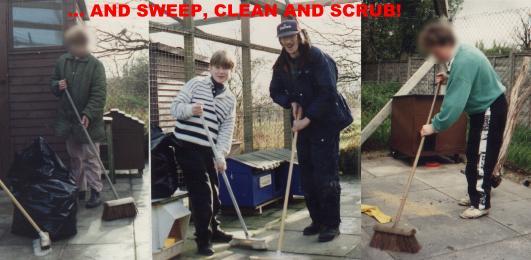
SO YOU WANT TO RUN A CAT SHELTER - A BRITISH SHELTER
These are my own personal notes and reminiscences from Chelmsford & District Cats Protection during the mid-to-late 1990s and might give aspiring shelter founders some idea of the work involved! They were originally compiled for presentations and talks and are a personal snapshot from that time. For current information and the official Cats Protection site, please go to Cats Protection The photos were taken during the mid-to-late 1990s. Since that time, several pens and ancillary sheds (kitchen area, litter-tray washing room) were rebuilt, improving facilities for cats and volunteers alike. This is therefore just a snapshot of the late 1990s.Cats Protection was founded in 1927 as The Cats Protection League and is Britainís oldest charity devoted exclusively to the welfare of cats and kittens. Local Branches are run by volunteers; half of whom also have full time jobs. Between them, CP volunteers do work equivalent to 2,600 full-time staff. This is an unofficial page is dedicated to the shelter in my geographical area and based on work and memories of the 1990s. Chelmsford branch was founded in 1963 to help cats in and around Chelmsford, Essex. In the late 1990s, it helped around 1000 each year through homing, neutering, veterinary treatment and trap-neuter-return (of ferals). Many more cats were helped by providing advice to owners and through the shelter's lost and found register.

The Shelter provided accommodation for homeable cats, pregnant cats and cats rearing kittens, isolation areas for cats requiring veterinary treatment and3 spacious enclosures for long-stay cats who cannot easily find homes due to age or temperament. The long-stay cats were supported by a Sponsorship scheme. At any one time the shelter had around 50 cats and kittens in care and many more on its waiting list. Some cats were rehomed directly from their previous homes without the need to come into shelter care. In addition, some kittens and young tameable ferals were cared for in foster homes prior to homing.
The main reasons for cats entering a shelter's care were break-up of the owner's relationship, conflict with a new baby or young child, owner's financial circumstances, allergy, death of the owner or straying/ abandonment. Stray cats are retained for a minimum of two weeks to allow the owner (if any) to collect them. In March 2001 alone, 3 cats in boxes/carriers were dumped at the shelter gates with no reason given. The cats themselves ranged from domestic pets, feral cats (e.g. if pregnant or pending neutering and return to site) and also some pedigree cats. Where possible, pedigree cats were referred to the appropriate pedigree rescue society. No cat was put to sleep except on genuine medical grounds.
A rescue shelter's aims:Some cats arrive at a shelter in excellent condition: healthy, friendly and easy to rehome. Others are strays, accident victims, neglect or cruelty cases and need vet treatment and tender loving care to rehabilitate them before rehoming. Some must learn to trust humans again. The branch also reunites a number of strays with their owners. Cats go to the shelter for various reasons: house repossession, unemployment or emigration. A new baby may be allergic to the cat. Sometimes the cat has disgraced itself or does not get on with other pets so the owners get rid of the cat. Some of the examples I encountered were:
The shelter must make sure that cats go to suitable homes. A nervous cat cannot go to a home with young or noisy children. A cat which dislikes other cats needs a home where it will be an only cat. Staff try to make sure the cat and owner are suited to each other. Potential owners are quizzed before they are allowed to adopt a cat.
Shelter staff do their best to make sure that cat and adopter are well-matched, but nobody's perfect and sometimes a cat genuinely does not settle in and is returned to the shelter. However, it is very disheartening when a cat is returned simply because it scratched the sofa. A volunteer often visits the new home a few weeks later to see if there are any settling-in problems and to answer any questions from the new owner.
Feral Cats in the Essex Area:
The shelter also dealt with feral, or wild, cats. Feral colonies form near farms and factories. Colonies are controlled by trapping the cats in box-traps, neutering them and returning them to site. If it is not possible to return them - maybe the site is being built on - the branch must look for a new home at a farm, stables or somewhere else where it can roam and hunt and is welcome. More and more ferals are losing their homes because of building works. This means there is a number of long-stay, hard-to-home cats in care. They live in spacious enclosures with sleeping sheds until they find suitable outdoor homes. A very few of them become tame of their own accord and can be rehomed to a patient and experienced person.
Feral kittens which are trapped when less than 10 weeks old can be tamed and grow up indistinguishable from pet kittens. Ferals up to the age of 6 months can sometimes be tamed. Older ferals rarely become tame and will not make good pets so it is kinder to return them to an environment where they will be supervised, but free. A paper about socialising feral kittens is available on the Messybeast.com Cat Resource Archive index.
Neutering (or Whatever Term You Prefer to Use!)
Rescue shelters insist on the neutering of all cats not required for breeding. By breeding, CP means genuine pedigree breeders, not people who just like to see kittens born. This means neutering ferals and working cats as well as pet cats. Neutering is the general unisex term meaning sterilization of females (spaying) and males (castration). Most people use the word neuter to mean castrate because it doesnít make your eyes water as much! Other terms for neutering are desexing, altering, fixing and even speutering which is a unisex term!
There are lots of myths about neutering. Neutering does not make cats fat and lazy - boredom and overfeeding makes them fat and lazy! Bored cats just sleep and eat. If this describes your cat, give him a clockwork mouse! Neutered cats are often better hunters as they donít take time off for family matters. Neutered males are less likely to spray smelly urine or fight with other tomcats. They are also less likely to roam because they arenít looking for girlfriends. Females in season call noisily to attract mates. You might decide to keep her indoors when she is on heat - that is every 2 or 3 weeks - if you can stand the noise. She will do her utmost to escape and every tomcat in the area will turn up outside your house and spray smelly urine as a calling card. Unmated females are prone to womb infections, which can kill, so it is far kinder and safer to have her spayed.
The belief that a female cat should have one litter before spaying is a myth. What youíve never had, you wonít miss! Kittening is stressful and often hazardous, sometimes the kittens or mother cat die as a result. And what will you do with all those extra kittens? There are already too many unwanted cats? Many kittens are abandoned when they grow out of the cute stage.
There's No Such Thing As A Kitten Shortage - Just Seasonal Fluctuations in Supply!
Are you worried that all this neutering will cause a kitten-shortage? Well it wonít. There is always someone who doesnít want to spoil her fun, or doesnít think itís natural. These someones are often the same people who drown or abandon unwanted cats and kittens and they never worry about the damage that having kittens all the time is doing to their cat. The people who complain that they can't find a kitten are generally trying to find kittens at the wrong time of year - a bit like looking for Easter Eggs at Christmas time!
An unspayed female can have 12 - 18 kittens each year, from the age of 6 months to 12 years (or older). If half of her kittens also have kittens there will be 20,000 extra cats in only 5 years. Each year, vets in Britain have to destroy around 40,000 unwanted, healthy, friendly cats and kittens. Many more are disposed of by owners. 9 out of 10 feral kittens die in their first year. Cats donít carry condoms, so family planning for cats is important!
Another source of kittens is feral colonies. CP, and other specialist organisations, help to control feral colonies by trapping, neutering and returning them. It is impossible to achieve a 100% success rate because cats move around so much. Some ferals are pregnant when trapped. A captive feral may reect or eat her kittens. If she is only just pregnant the vet can perform an abortion and spay her at the same time so she can be returned to site more quickly. If the pregnancy is too far advanced, the shelter keeps her until the kittens can be homed and the mother spayed. Feral kittens become tame is handled while young. Abortion is an emotive subject, but it is often kinder for the cat and far less distressing than keeping her in a pen for several weeks.
Informing the Public on Cat Care

The third basic aim of a welfare organisation is to inform the public on cat care. Despite the many books on cat and kitten care, many people donít really know how to look after their cats properly. CP produces a number of leaflets ranging from Basic Cat Care and feeding to First Aid, Illnesses and Euthanasia. Leaflets are available at local fayres, national cat shows and from the Shelter itself. They are free and they present information in a clear and helpful way. There are also leaflets and newsletters for children aged 5-11 years old. They are also available from Headquarters at Cats Protection
A Little Bit About The Shelter.
During the 1990s, the shelter had around 50 cats in care at any one time. 20 of these were long-stay cats in the large enclosures mentioned earlier. The rest were pets which needed new homes for whatever reason. During the main kitten season, from April to September, life became even more hectic. There were 9 special kitten pens for females with kittens to accommodate pregnant and nursing females.

The volunteersí day began around 8 a.m. when the cats were fed. They got through 24 cans of food and 4 packets of crunchies for breakfast. After breakfast, all the litter trays were replaced with clean ones. The old litter trays were emptied and disinfected before being refilled and stacked ready for use the next day.

Every, pen, run and shed had to be cleaned and disinfected to prevent spread of any germs. Some cats are very clean and very co-operative at cleaning time. Others spend their nights shredding paper, spraying the walls and spreading litter around the pen, then they sit in the middle and refuse to budge when you try to clean out! A few resented any intrusion into their territory and hissed, scratched ... or worse. Volunteers have to remember that such cats are frightened of people, even if they are doing their best to scare humans!

Sick cats were given their medication and cats were taken to the vet for neutering. Throughout the morning there were visitors looking for new cats or bringing in cats. The shelter accepted cats on a waiting list basis, except in dire emergencies. The cats were fed again in the early evening - another 24 cans of cat food - and any solids were removed from the litter trays. This used around 50 cans of food daily, plus a variety of prescription foods. I didn't even calculate how many sacks of cat litter were used - this being mostly recycled product litter e.g. that made from waste paper or wood pulp, though at one time sawdust from a local mill was used.

Each season brought different problems. In winter the heating bills went up, especially for sick or elderly cats. Snow was a problem for the outdoor cats and volunteers had to make sure the cats didn't get snowed into their sheds. Volunteers shovelled away enough snow for the cats to get fresh air and exercise. Being a British winter, When it didn't snow, it rained, and the area was flood prone. Water sometimes had to be pumped out of some of the runs and immediately the ground dried up, the paving had to be re-laid because of subsidence. Immediately the new year arrives, people asked for kittens. This is like asking for Easter Eggs in August! Some complained about a kitten shortage caused by shelter neutering policies, forgetting that it was far too early for kittens. If they waited until summer they would find shelters up to their ears in kittens as there is no shortage at all. It is a sad fact of life that out of every 5 kittens born in Britain, only one will find a loving, permanent home; many others end up straying or abandoned.
Spring saw the beginning of the kitten season proper. Although a few kittens are born earlier, most arrive from April onwards. This is also the time when shelters get the unwanted Christmas presents as they have become old enough for neutering. The owners often decide that it is too expensive and by the time the cats arrive at shelters they are often pregnant. The British housing (real estate) market picks up during spring and people moving into new homes sometimes find cats left behind by the previous tenant. One case I came across involved 5 cats and 6 kittens, but the previous tenant claimed that the cats had been dumped in his garden after he had moved out. Spring was often a wet and muddy time for volunteers working at the shelter.
Believe it or not, Britain does have a hot season and it is important to provide the cats with shade during the height of summer - visitors to the shelter saw sheets pegged to the wire mesh to provide extra shade. In summer, many cats are abandoned when the owners go on holiday and donít bother about getting someone to care for their pets. Because of holidays, summer is a slow time for homing cats and kittens. There is also a steady stream of kittens arriving at shelters from people who believe the just one litter myth and also from cats abandoned when they are no longer kittens. Most shelters also get kittens dumped at the gates in boxes and carrier bags. In 1993 a cat lover rescued 2 kittens from a bag thrown into the canal and another rescued 6 kittens and their mothers from being drowned in a box.
By midsummer, far from there being a kitten shortage, some cat rescuers have collapsible pens at home to cope with the number of kittens coming in (some shelters have additional permanent pens in volunteers gardens). In a recession the problems become worse because people canít afford the cost of neutering and cheap-neutering clinics usually only neuter tomcats as this is cheaper, but not an effective method of birth control. They are enough stray tomcats around to serve all the unspayed females, so it is important to get the females spayed - after all they are the kitten machines. During the late 1990s, the branch was still mopping up these effects of the recession.
Autumn hopefully meant fewer kittens arriving and more adult cats being homed. But it was also the run-up to Christmas and all animal shelters must screen potential homes even more carefully to check that cats arenít being adopted as Christmas presents. Leaf-clearing was added to the list of chores. Hopefully autumn is the time when some pens are empty for a while and staff can do essential maintenance work to keep the shelter in good repair.
Fundraising
Whatever the season, I found there were plenty of jobs to do; not just at the shelter, but also preparing for fundraising events and for participation in various national awareness/fundraiser events such as National Pet Week in May and National Cat Week in September. Apart from a discretionary grant from HQ, CP branches raise all of their own funds. At the time this was originally written (1993) it cost around £40,000 annually to run the shelter and help needy cats in the shelter's catchment area. This was all done through local membership, sponsorship, fundraising events, donations and legacies. The National Lottery made it much harder for many charities to raise funds as people often want that spare £1 for a lottery ticket instead of giving it to charity.
|
|
|
Sponsorship of long-stay cats was an import source of income. The branch also had 3 major fayres each year and and smaller events. Some members held their own fundraising events such as garden parties, coffee mornings, sponsored somethings or they had stalls at boot fayres and table top sales. Others make craft items and cakes or collected and sorted jumble and other saleable items. During the 1990s, there were regular rummage sales at a church hall in Chelmsford. Donations of food and litter were also welcome and several members bought extra cans of food each week to donate to cats in care. At one time, there was a food collection point at Pet City. Most years, there were collections in Chelmsford High Street and High Chelmer Precinct during Spring and in The Meadows Precinct in the Autumn. Local membership subscriptions and sales of badged items, tee-shirts and sweatshirts were another source of funds.
The shelter was open to the public most mornings, except for the Christmas shutdown. Not everyone who visited was adopting a cat. Some came for advice, to help clean, to tidy our gardens or to bring donations, food, litter or blankets. Sponsors of long-stay cats also came to visit their cat from time to time.